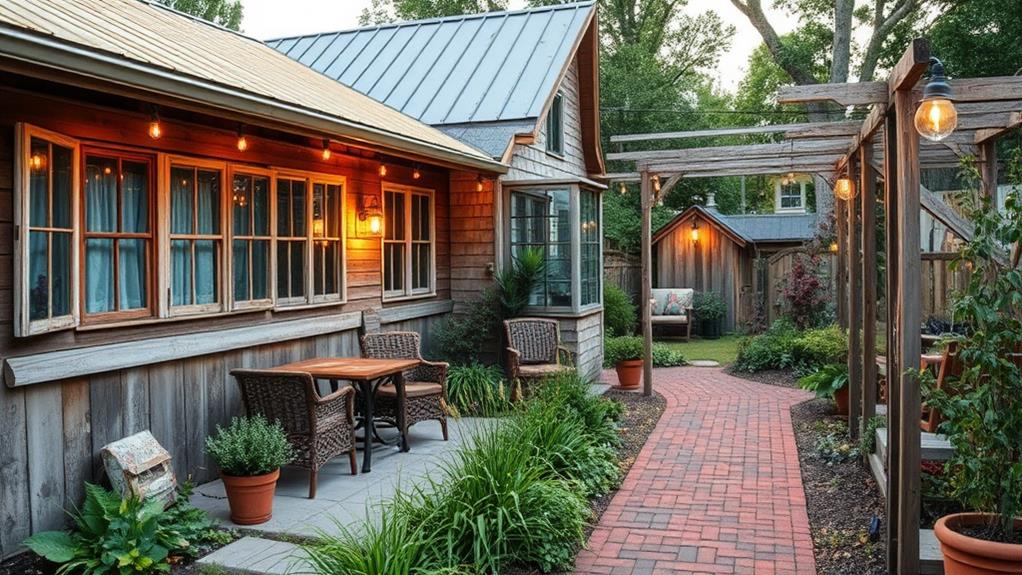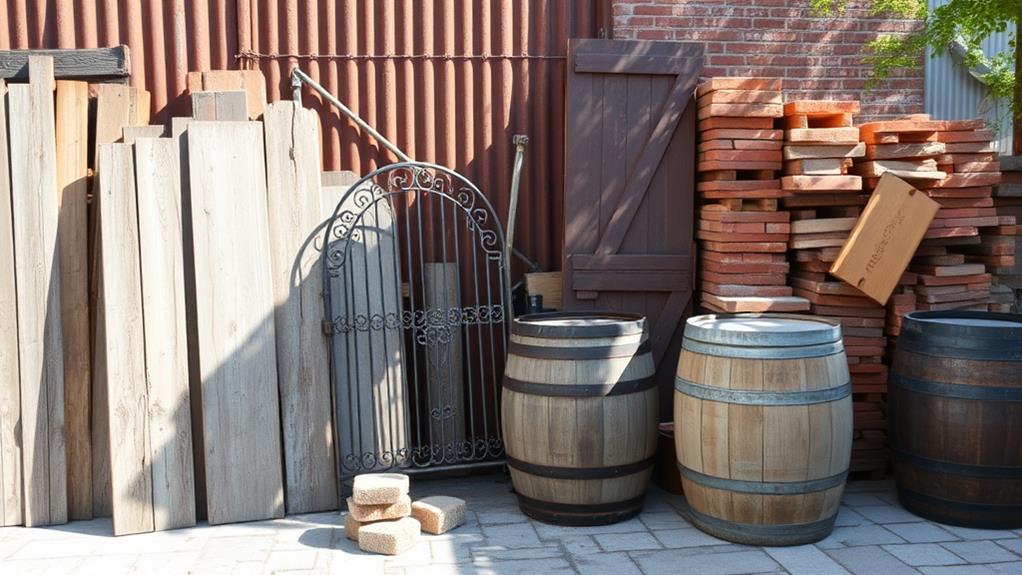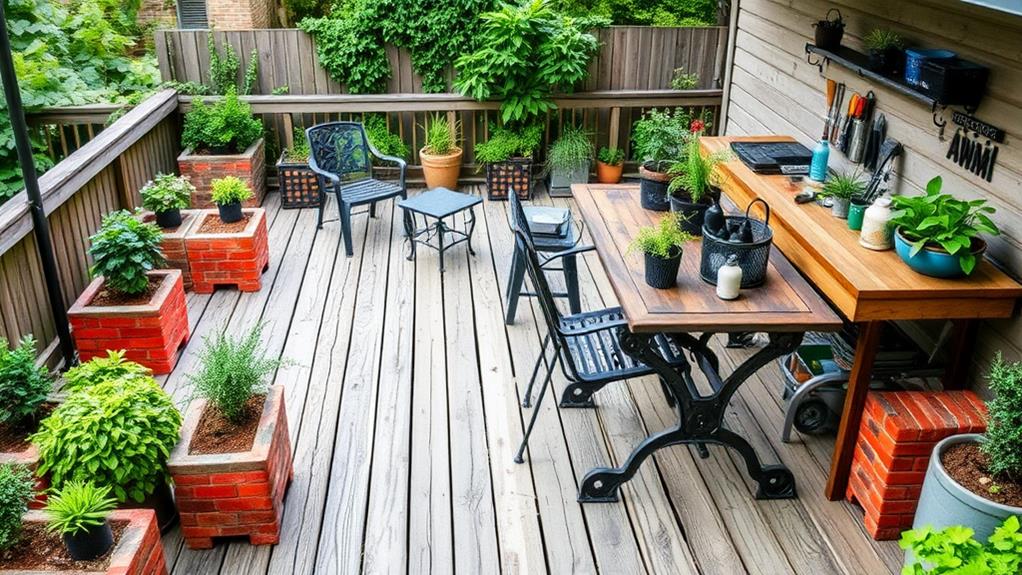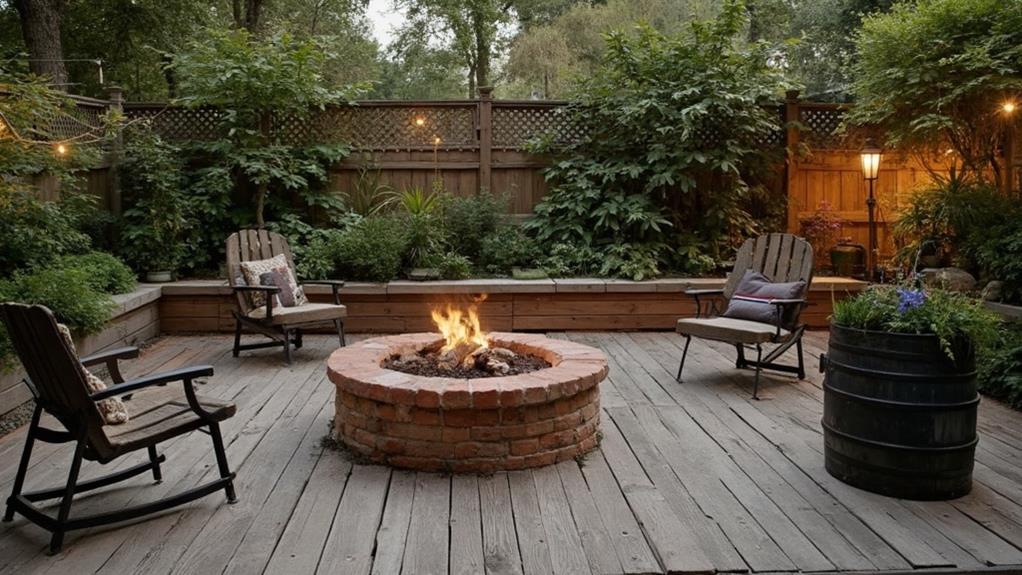Renovating outdoor spaces with reclaimed materials offers numerous benefits for sustainable living. It reduces landfill waste, conserves resources, and adds unique character to your outdoor areas. Popular options include reclaimed wood for decking, salvaged brick for pathways, and recycled metal for decorative accents. These materials can be sourced locally, supporting eco-friendly practices and local economies. Design ideas range from weathered barn wood fencing to repurposed vintage doors as garden gates. Proper installation and maintenance ensure longevity, while cost savings can be realized through energy-efficient lighting and water conservation systems. Exploring sustainable outdoor renovations can transform your space while minimizing environmental impact.
Benefits of Reclaimed Materials

When we consider sustainable outdoor living, reclaimed materials offer a wealth of benefits. These materials, repurposed from old structures or discarded items, contribute significantly to environmental conservation by reducing landfill waste and minimizing the demand for new resources.
Reclaimed wood, metal, and stone not only possess unique character and history but also often exhibit superior quality due to their age and prior use.
Incorporating reclaimed materials into outdoor living spaces can lead to substantial cost savings compared to purchasing new items. This approach allows homeowners to create distinctive, high-end designs while staying within budget. Additionally, using reclaimed materials supports local economies by creating jobs in salvage and restoration industries.
From an aesthetic perspective, reclaimed materials add warmth, texture, and authenticity to outdoor spaces. Whether it's weathered barn wood for decking or vintage brick for pathways, these elements infuse charm and personality into landscapes. Furthermore, reclaimed materials often require less maintenance and have proven durability, having already withstood the test of time.
Sourcing Sustainable Outdoor Elements
Building upon the benefits of reclaimed materials, it's important to consider the broader scope of sourcing sustainable outdoor elements. This involves seeking out eco-friendly materials and products that minimize environmental impact while enhancing outdoor living spaces. When sourcing sustainable elements, prioritize items made from recycled or renewable materials, such as composite decking, bamboo furniture, or recycled plastic outdoor rugs.
Look for locally sourced materials to reduce transportation emissions and support regional economies. Consider native plants for landscaping, as they require less water and maintenance while supporting local ecosystems. Incorporate energy-efficient outdoor lighting options, such as solar-powered fixtures or LED bulbs. Water conservation is crucial, so explore rainwater harvesting systems and drought-resistant landscaping techniques.
When selecting outdoor furniture and accessories, opt for durable, weather-resistant materials that will withstand the elements and reduce the need for frequent replacements. Seek out products with eco-certifications or from companies with transparent sustainability practices. By carefully sourcing sustainable outdoor elements, you can create a beautiful, environmentally responsible outdoor living space that aligns with your values and reduces your ecological footprint.
Popular Reclaimed Material Options

As the trend towards sustainable outdoor living grows, reclaimed materials have become increasingly popular for creating unique and environmentally friendly outdoor spaces. These materials offer both aesthetic appeal and eco-conscious benefits, making them ideal for outdoor renovations.
Reclaimed wood is a versatile and widely used option, sourced from old barns, factories, or deconstructed buildings. It can be repurposed for decking, fencing, or outdoor furniture. Salvaged brick and stone are excellent choices for pathways, retaining walls, or fire pits, adding character and durability to outdoor areas.
Recycled metal, such as corrugated tin or wrought iron, can be transformed into stylish planters, trellises, or decorative accents. Repurposed glass bottles or windows make unique garden art or greenhouse materials. Reclaimed concrete, often crushed and used as aggregate, is perfect for pathways or as a base for patios.
Other popular options include reclaimed railroad ties for raised garden beds, old doors repurposed as outdoor tables, and salvaged architectural elements like columns or shutters for decorative features. These materials not only reduce waste but also infuse outdoor spaces with history and character.
Design Ideas and Inspiration
Incorporating reclaimed materials into outdoor spaces opens up a world of creative design possibilities. From rustic patios to eclectic garden features, reclaimed elements add character and sustainability to outdoor living areas. Consider using weathered barn wood for deck flooring or fencing, creating a warm, inviting atmosphere. Repurposed metal sheets can be transformed into unique privacy screens or artistic wall panels, adding industrial flair to modern landscapes.
For seating areas, old wooden cable spools make excellent tables, while reclaimed stone or brick can be used to construct fire pits or outdoor kitchens. Vintage doors can be repurposed as garden gates or mounted on walls as decorative elements. Salvaged windows can become charming greenhouse structures or hanging planters.
In garden design, incorporate antique farm equipment as sculptural elements or plant containers. Use reclaimed timber to build raised beds or create vertical gardens. Old ladders can be repurposed as plant stands or trellises for climbing vines. For lighting, transform vintage lanterns or industrial fixtures into statement pieces that illuminate outdoor spaces while adding nostalgic charm.
Installation and Maintenance Tips

How can homeowners ensure their sustainable outdoor living spaces remain beautiful and functional for years to come? Proper installation and regular maintenance are key to preserving the longevity and appeal of reclaimed materials in outdoor settings.
When installing reclaimed wood, treat it with a protective sealant to guard against moisture and UV damage. For reclaimed stone or brick, use appropriate mortar and ensure proper drainage to prevent water accumulation. Install recycled metal elements with corrosion-resistant fasteners and apply a rust-inhibiting coating if necessary.
Maintain wood surfaces by cleaning them annually with a mild soap solution and reapplying sealant as needed. Inspect for signs of rot or insect damage regularly. For stone and brick, remove debris and weeds from joints, and repoint mortar when it shows signs of deterioration. Clean metal surfaces periodically and touch up any scratches or rust spots promptly.
Address any issues immediately to prevent further damage. Consider professional maintenance for more complex elements or extensive outdoor living spaces. By following these installation and maintenance tips, homeowners can enjoy their sustainable outdoor living areas for many years while minimizing the need for replacements or extensive repairs.
Cost Considerations and Savings
While proper installation and maintenance are vital for longevity, the financial aspects of sustainable outdoor living spaces also warrant careful consideration. Initially, sustainable materials and eco-friendly designs may appear more expensive than conventional options. However, the long-term cost savings often outweigh the upfront investment.
Energy-efficient outdoor lighting, such as solar-powered fixtures, can significantly reduce electricity bills. Water-saving features like rainwater harvesting systems and drought-resistant landscaping minimize water consumption and associated costs. Choosing durable, low-maintenance materials like composite decking or reclaimed wood can decrease ongoing repair and replacement expenses.
Additionally, many sustainable outdoor living projects qualify for tax incentives or rebates, further offsetting initial costs. Some local governments offer property tax reductions for implementing green features, while utility companies may provide rebates for energy-efficient outdoor appliances.
When budgeting, consider the potential increase in property value that sustainable outdoor improvements can bring. Many homebuyers are willing to pay a premium for eco-friendly features, making these renovations a sound investment for the future.
Frequently Asked Questions
How Do I Verify the Authenticity of Reclaimed Materials?
To verify the authenticity of reclaimed materials, examine documentation and certifications from reputable suppliers. Look for signs of age and wear, research the material's history, and consult experts in architectural salvage or antique building materials for professional assessments.
Are There Any Health Risks Associated With Using Reclaimed Materials Outdoors?
Just as Pandora's box held hidden surprises, reclaimed materials can harbor potential health risks. Lead paint, asbestos, and chemical treatments may pose hazards. Properly sourcing, testing, and treating materials is crucial to ensure safety in outdoor applications.
Can Reclaimed Materials Affect My Home's Resale Value?
Reclaimed materials can positively impact your home's resale value when used thoughtfully and professionally. They add character, uniqueness, and eco-friendly appeal. However, poor quality or improper installation may negatively affect value. Consult a real estate professional for specific guidance.
What Permits Are Required for Outdoor Renovations Using Reclaimed Materials?
Permits required for outdoor renovations using reclaimed materials typically depend on local regulations. Common permits include building, zoning, electrical, and plumbing. Always check with your local building department to ensure compliance with specific requirements for your project.
How Do I Incorporate Reclaimed Materials With Modern Outdoor Technology?
To incorporate reclaimed materials with modern outdoor technology, consider integrating salvaged wood for decking or furniture alongside solar-powered lighting. Use repurposed metal for custom fire pit designs, and blend vintage elements with smart irrigation systems for a harmonious blend.
Conclusion
Reclaiming materials for outdoor living spaces weaves a tapestry of sustainability and style. Like a phoenix rising from the ashes, discarded elements find new life in gardens and patios. This eco-conscious approach not only reduces environmental impact but also infuses spaces with character and history. As the seeds of sustainable design take root, outdoor areas blossom into unique havens that tell stories of the past while nurturing a greener future. The path to sustainable outdoor living is paved with reclaimed treasures.

